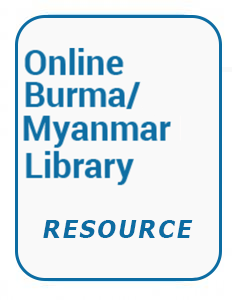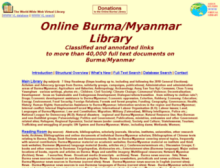Resource information
EXECUTIVE SUMMARY:
"In September 2002 the Thailand Burma Border Consortium (TBBC), formerly the
Burmese Border Consortium, compiled a report “Internally Displaced People and
Relocation Sites in Eastern Burma”. The report was written because although the
Royal Thai Government was reluctant to accept more refugees and believed repatriation
should occur as soon as conditions were judged suitable, new refugees were still
arriving in Thailand. Since most of the new arrivals reported that they had formerly
been living as internally displaced persons, TBBC considered that it was important to
understand what was happening in the border areas before any planning for repatriation
could begin.
Since that time, the nature and scale of internal displacement in eastern Burma has
been generally acknowledged, and humanitarian agencies based in Burma have been
increasingly requesting and gaining access to some border areas. In particular, the
United Nations High Commissioner for Refugees (UNHCR) Myanmar has negotiated
roving access to a number of townships of potential refugee return’. UNHCR Thailand
has also been engaging the Royal Thai Government, donors and non governmental
organisations (NGOs) in a conceptual planning exercise for the eventual repatriation
of the refugees.
Much of Eastern Burma is, however, still inaccessible to international observers from
inside the country and the initial steps being taken towards planning for repatriation
make it even more important to understand what is happening in these areas. This
report draws together the results of new surveys carried out by local community
organisations who collectively have broad access to the border areas.
Community organizations conducted field surveys across eastern Burma between April
and July 2004.1 Population estimates have been gathered from key informants in 36
significant townships and cross-checked with estimates from other local humanitarian
and human rights agencies wherever possible. Vulnerability indicators were also
developed from a multi-stage cluster survey of 6,070 people and 1,071 households
in 60 areas spread over six states and divisions. The sample population for this
quantitative survey was distributed between internally displaced persons in free-fire
areas, government relocation sites, ethnic ceasefire areas and mixed administration
areas.
Estimates recorded during this survey in 2004 indicate at least another 157,000
civilians have been displaced by war or human rights abuses since the end of 2002.
This includes people from at least 240 villages which have been documented
as completely destroyed, relocated or abandoned during the past two years. The
current status of villages forcibly relocated prior to 2002 has not been comprehensively
assessed, but attempts to return and re-establish more than 100 such villages
in Tenasserim Division have been documented as thwarted by further displacement.
Civilian displacement has continued at a high rate even though there has been a significant decrease in the number of villages forcibly relocated since the mid-late
1990s. This trend is indicative of the extent to which government troops had been
deployed and villages forcibly evicted prior to 2002. Since then, the military government
has been consolidating, rather than expanding, areas of control. High rates of civilian
displacement in areas where forced village relocations have decreased are attributed
to the harassment of people who had already deserted SPDC relocation sites to
attempt returning to their village or resettlement nearby. The total number of internally displaced persons (IDPs) who have been forced
or obliged to leave their homes and have not been able to return or resettle and
reintegrate into society as of late 2004 is estimated to be at least 526,000 people.
The population consists of 365,000 people in the temporary settlements of ceasefire
areas administered by ethnic nationalities, while 84,000 civilians are estimated to be
hiding from the military-government in free-fire areas and approximately 77,000
villagers still remain in designated relocation sites after having been forcibly evicted
from their homes. This represents a decrease since 2002 when 633,000 people were
estimated to be internally displaced in hiding sites, temporary shelters and relocation
sites. This decrease can be attributed to a mix of sustainable return or resettlement,
forced migration into the fringes of urban and rural communities, flight into refugee
and migrant populations in Thailand and methodological differences in data
collection. Speculation remains as to how many people on the fringes of rural and
urban communities have been obliged to leave their homes and are unable to resettle
and reintegrate, but whose status as internally displaced persons can not be verified. Indicators of vulnerability for the internally displaced population reflect a critical
situation. The survey found that more than half of internally displaced households
have been forced to work without compensation and have been extorted of cash or
property during the past year. While these and other human rights abuses were
widespread and a lack of protection was common in all areas, people in relocation
sites have reportedly been affected the most.
Livelihoods in free-fire areas are demonstrated as largely dependent on subsistenceoriented
slash and burn agriculture, yet still they are undermined by government
patrols searching for and destroying crops. Conversely, less households were
documented in relocation sites than elsewhere as being involved in any type of rice
farming, indicating a lack of access to land and greater restrictions on movement.
Yet the survey also found the highest rates of hunting and gathering were in densely
populated ceasefire areas, which is indicative of the livelihood constraints of
resettlement into these areas.
This report presents indicators which suggest there is a public health emergency
amongst internally displaced persons in eastern Burma. A third of households
surveyed had not been able to access any health services during the past year,
contributing to high mortality rates from infectious diseases which can be prevented
and treated, such as malaria. Child mortality and malnutrition rates are double Burma’s
national baseline rate and comparable to those recorded amongst internally displaced
populations in the Horn of Africa.
The population structure shows significantly more children dependent on a smaller
proportion of working age adults compared to official data sources for Burma. This
working age adult population consists of a high proportion of women representing
greater rates of mortality, economic migration, flight from abuse and military
conscription amongst young adult men. Low levels of access to durable shelter are
recorded and associated not only with limited protection from the climate but also
adverse impacts on health and human dignity. Similarly, low levels of educational
attainment are likely to restrict the capacity of internally displaced persons to cope
and recover from all of these aspects of vulnerability.
The surveys demonstrate that the problem of forced migration in Eastern Burma
remains large and complex and that internally displaced populations are extremely
vulnerable. As in 2002, TBBC presents this compilation of data without making
any recommendations. The intention is that policy makers and humanitarian
organisations might be better informed in terms of preparing for refugee repatriation
and addressing the situation of internal displacement itself.



